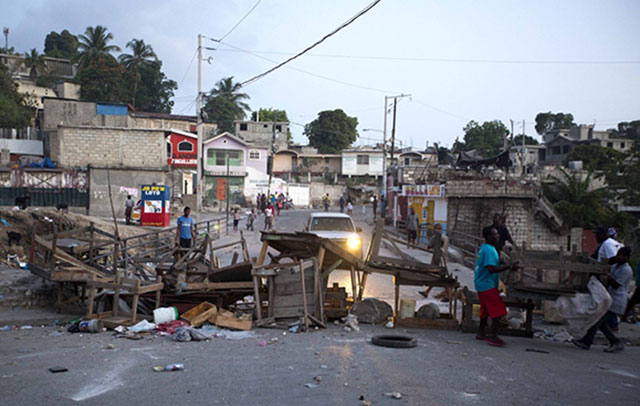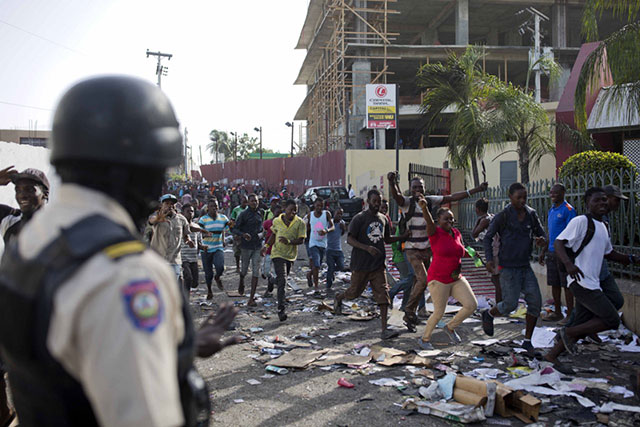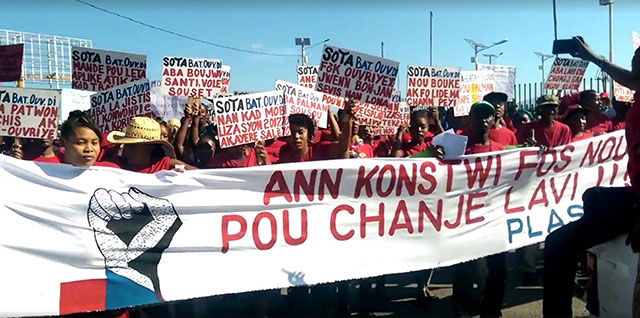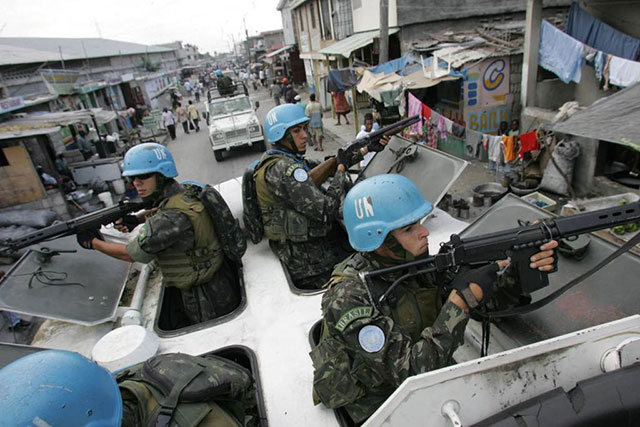
August 2018
Unite with Dominican and U.S. Workers to Defeat Imperialist Attack!
Revolt in Haiti Against
IMF-Dictated Austerity

Protesters build barricade in street of Haitian capital, Port-au-Prince, on July 7 during rebellion against fuel price hikes ordered by imperialist agencies. (Photo: Dieu Nalio Chery/AP)
At 4 p.m. on Friday, July 6 while Haitians watched the World Cup of soccer on television, the right-wing government of Prime Minister Jack Guy Lafontant announced that, effective the next day, it was raising the price of gasoline by 38%, diesel fuel by 47% and kerosene by 51%. Kerosene is used for lighting and cooking by Haiti’s poor, most of whom do not have access to electricity. This massive price hike would result in a huge increase in the cost of living anywhere in the world, but in Haiti, a deeply impoverished country with widespread malnutrition, it spells disaster for several million people living on the edge of survival. And it was ordered straight from Washington, where the virulently racist U.S. president declared Haiti a “shithole country.”
To no one’s surprise but that of Haiti’s government and its imperialist overlords in the U.S., the country exploded in protest. Two days of flaming barricades rattled the tiny ruling class as angry crowds besieged upscale hotels, burned cars, gas stations and banks, and sacked a chain of supermarkets owned by the wealthiest family in Haiti. Some of the rich were evacuated from their rooftops by helicopter. In less than 24 hours, by the afternoon of July 7, Lafontant announced the “suspension” of the fuel price hike “until further notice,” later confirmed by President Jovenel Moïse. But that didn’t stop the popular uprising, as a general strike shut down transportation nationwide. It was the biggest upheaval in Haiti in years.

Protesters burned Delimart supermarket to the ground in Port-au-Prince, during rebellion against fuel price hikes. (Photo: Dieu Nalio Chery/AP)
The raising of fuel prices was dictated by the International Monetary Fund (IMF), the international bankers’ cartel, as part of a deal reached in February with the Haitian government for a “staff-monitored program.” In exchange for promises of $96 million in loans, the IMF demanded cuts to fuel and electricity “subsidies” and further privatization of Electicité d’Haiti, the state electric utility. These are the same brutal austerity policies that the IMF and other imperialist institutions like the World Bank and the European Central Bank have regularly imposed on countries in difficult economic straits, from Latin America to Greece.
The cynicism of the operation was stunning. In preparation, at a cost of millions of dollars the government distributed 3,000 large (65-inch) and expensive flat-screen television monitors to every senator and deputy (a little under 20 TVs each), supposedly so that in every town and village people could watch the World Cup. The Moïse/Lafontant government figured that, with all of Haiti rooting for Brazil – the powerhouse of world soccer – in its match with tiny Belgium, the masses wouldn’t pay attention to the fuel price hike in the euphoria after Brazil’s predictable victory. But to everyone’s surprise, Brazil lost. Big miscalculation.
Within minutes of Brazil’s defeat, enraged Haitians took to the streets in protest. Massive crowds erupted in the capital, Port-au-Prince, spreading to the cities of Les Cayes, Cap-Haïtien, Jérémie, and Petit-Goâve. Barricades of burning tires and vehicles on the roads shut down transportation. The police were ordered to suppress the upheaval, but, overwhelmed by the size and militancy of the protests, they retreated, leaving the crowds in control of the streets. International telephone and internet service was disrupted and all flights in and out of Toussaint Louverture International Airport were cancelled. A small contingent of Marines arrived to stand guard at the U.S. embassy. Several people were killed, and in coming days over 100 arrested.
As the rebellion continued the next day and the government backed down, protesters demanded more. A coordinating committee composed of transportation unions and social organizations called a general strike on July 9 and 10. Demands of the strike included: permanent suspension of the fuel price hike; reinstatement of workers fired from state-owned companies; the arrest of corrupt officials implicated in the theft of funds from the Petrocaribe program, in which Venezuela provided oil to Caribbean countries on favorable terms; and the ouster of both Lafontant and Moïse. Protesters marched on parliament, where they were stopped by police.
Meanwhile, the Private Sector Economic Forum, representing Haiti’s capitalists, denounced the “barbarity” of the masses in revolt, even as it called for the resignation of the prime minister. The Haitian legislature, hoping to demobilize the protests and restore bourgeois order, prepared to remove Lafontant through a vote of no confidence. The “Core Group” of the U.S., Canadian and European ambassadors demanded that Haitians “respect the constitutional order” – i.e., the prime minister can go but the president must stay. Finally, in the midst of a heated legislative debate on July 14, Lafontant suddenly announced that he had already resigned.
But nothing has changed that will restore stability. Even after the revolt, the IMF is insisting on an end to “fuel subsidies,” to be implemented more gradually. Yet fuel prices in Haiti are not subsidized. Even at the current average price of roughly $70 per barrel of crude oil (up sharply from $43 a year ago), the production, refining and distribution cost of gasoline is around $2.50 a gallon. The current price per gallon to users in Haiti is US$3.45 (compared to $2.99 in the U.S.). With the IMF-ordered “adjustment,” that would have risen to $4.75 a gallon, in a country where the top minimum wage is $5.15 a day and half the population lives on less than $2.40 a day.1
Imagine paying almost a full day’s wage to pay for a gallon of gasoline, or of kerosene for cooking and lighting! The fuel price increases would also raise bus fares. The Miami Herald (13 July) calculated that: “A domestic worker with two children, for example, who makes the daily $4.39 minimum salary and lives in the city of Petionville, would spend almost half of her daily wages just to get the children to and from school at a cost of $1.82.” To deal with that, the geniuses at the IMF called for “compensatory mechanisms” like transportation vouchers for the poor. But Haiti has no apparatus to distribute such vouchers (which would, of course, soon be counterfeited), nor to force bus operators to accept them, which they wouldn’t.
What this is all about is the financial dictators of the IMF imposing an additional tax of 85 gourdes (Haiti’s currency), or the equivalent of 1 € (euro), or US$1.30 per gallon on fuel in order to increase government revenue by US$160 million. This is almost exactly the size of its budget deficit. Other measures could have been taken instead. An article by the Haiti Relief and Reconstruction Watch of the liberal Center for Economic and Policy Research in Washington, noted: “For example, last year, Haiti lost almost the exact same amount of money from tax exemptions granted to free trade zones, businesses, NGOs and diplomatic missions.”2 This is a deliberate, massive attack on the living standards of the poor and working people.
And increased government revenue will surely not finance “badly needed public investments and a better social safety net,” as an IMF spokesman claimed. This was driven home by a report of a parliamentary investigation last November that some US$3.8 billion in the Petrocaribe program, loaned funds from Venezuela’s state oil company intended for infrastructure and other development, was mostly embezzled by Haitian politicians and officials, as well as scamming business owners. The accused include two former prime ministers. Such corruption has been business-as-usual among Haiti’s rulers, but particularly since the July uprising against the fuel price hikes, an anti-corruption campaign called #petrocaribechallenge has taken off.
Already before the current revolt, Haiti was simmering with protests against rising food and transportation costs and for higher wages. As Kim Ives reported in Haïti Liberté (11 July), the Kreyól watchword of the revolt was “‘nou bouke,’ meaning ‘we are fed up’.” Last year, garment workers’ unions waged militant strikes calling to more than double the minimum wage.3 The minimum wage in Haiti is set at various levels for different types of workers – the highest rate being 350 gourdes (US$5.15) per day, which is a little over 50 cents an hour for a ten-hour day. In 2009, Hillary Clinton, Obama’s Secretary of State, directly intervened to stop a proposed increase in the minimum wage in Haiti.4

Garment workers of SOTA union, led by Batay Ouvriye, march on May Day 2018. To defeat imperialist-dictated
austerity it is necessary to mobilize workers power, from Haiti to the Dominican Republic and the U.S.
(Photo: Rapid Response Network)
Wage increases have been fought by President Moïse, who is a puppet of U.S. imperialism. A banana plantation owner, Moise was elected in a 2016 election farce (financed by the Obama administration) in which less than one in five Haitians voted, following 2015 elections that were scrapped due to massive fraud. Moïse was the candidate of the Haitian Bald-Headed Party (PHTK) and hand-picked successor to pop singer Michel “Sweet Micky” Martelly, who in his younger days was a supporter of the bloody, U.S-backed Duvalier dictatorship (1957-86), and later continued to maintain ties to Duvalierist coup plotters.5 Martelly won the presidency in 2011 after U.S. Secretary of State Hillary Clinton intervened to change the election results. Clinton threatened that if Martelly was not inserted into the runoff election the U.S. would withhold relief funds – in the aftermath of the devastating 2010 earthquake!
Martelly repaid the Clintons (Bill was designated as Haiti’s colonial overseer by the United Nations in 2009) with support to the interests of foreign investors as well as imperialist military occupation. In 2012, Martelly and the Clintons held a glitzy ceremony celebrating their “great achievement,” the opening of the Caracol industrial park, which houses textile sweatshops and was built through diverting earthquake relief funds. During the 2016 presidential election campaign, Donald Trump declared, accurately: “Hillary Clinton set aside environmental and labor rules to help a South Korean company with a record of violating workers’ rights set up what amounts to a sweatshop in Haiti.” 6
One reason protesters could dominate Haiti’s streets for four days is that United Nations MINUSTAH troops were withdrawn last October. The 13-year (2004-17) military occupation by U.N. “blue berets,” acting as mercenaries for the U.S. under Brazilian command, was notorious not just for repression of popular struggles but also for sexual assaults against Haitian women and men. Amid the devastation after the 2010 earthquake, United Nations troops introduced cholera to Haiti in the deadliest epidemic in recent history, an ongoing tragedy that has killed almost 10,000 Haitians and sickened over 800,000. Finally acknowledging responsibility in 2016, the U.N. has provided almost no compensation to its victims.

MINUSTAH troops under Brazilian command patrol Cité Soleil neighborhood, February 2006. Six months earlier the mercenary imperialist occupation force carried out massacre in the neighborhood, killing scores.
(Photo: Roberto Schmidt/AFP)
Today the MINUSTAH has been replaced by MINUJUSTH, which has brought in hundreds of police to beef up Haiti’s National Police. Meanwhile, the month after U.N. troops departed, President Moïse refounded the Haitian Armed Forces (FAdH). In mid-March, the names of the Army high command were announced, all of whom were former officers of the FAdH before it was disbanded in 1995 (by U.S. occupation forces). Of the six, three were leading members of the early 1990s military junta, one was the mastermind of the notorious 1994 Raboteau massacre and a fifth helped cover it up. 7 Now, following the July uprising, army and police commanders have been meeting with the president to plan for heavy-duty repression of the next revolt.
The United States itself has sent in troops to Haiti many times since 1891, including the 1915-34 occupation and the 1994 invasion ordered by the Clinton administration to reinstall the former priest Jean-Bertrand Aristide as president – after Aristide agreed to ditch his populist program in favor of U.S.-approved “structural reform.” His Fanmi Lavalas party retains some populist tinge, but it is a party of a wing of the bourgeoisie, including Aristide. Petty-bourgeois leftists in Haiti and the U.S. have tailed after Aristide for decades. Following the January 2010 earthquake, the Obama administration sent troops again to take over Haiti while blocking Haitian refugees at sea, with Bill Clinton as U.N. plenipotentiary and de facto gouverneur.8
The July uprising staved off the imposition of the IMF-dictated fuel price hike … for now. But given the powerful array of forces determined to keep Haiti under the imperialist boot, the Haitian masses cannot win on their own. Nor are they alone in experiencing the depredations of decaying capitalism and its “neo-liberal” policies of “free trade,” privatization and destruction of social and labor gains. In January 2017 Mexican truckers struck against fuel price increases imposed as part of an imperialist-ordered “energy reform.”9And this past May, truckers in Brazil revolted against the unelected government’s attempt to raise diesel fuel prices to international levels.10 In both cases, the government backed off, temporarily.
If, however, as the Grupo Internacionalista in Mexico and the Liga Quarta-Internacionalista do Brasil, sections of the League for the Fourth International, called for, a powerful independent workers movement had taken over leadership of the largely petty-bourgeois protests, they could have dealt a heavy defeat to the imperialist-backed privatizers. This, in turn, could have launched a proletarian counteroffensive against the privatizers and tax gougers in Washington (IMF, IADB, IBRD, World Bank) and Wall Street. Building proletarian opposition in major industrial countries is how to stop the arrogant imperialist economists from foisting their “soak the poor” policies on Haiti. But such a class struggle requires revolutionary internationalist leadership.
That should begin by joining together with workers next door in the Dominican Republic, where there have been numerous (unsuccessful) strikes against fuel price hikes, and where the gasoline price at the pump is currently around US$4.80 a gallon. Haiti – home of the only successful slave revolution in history, overthrowing French rule at the end of the 18th century – shares the island of Quisqueya (Hispaniola) with the DR. Both have populations of around 10 million, both are mired in poverty (Haiti much more so) and both have been repeatedly occupied by the Yankee imperialists. But for Dominican and Haitian workers to unite requires a head-on struggle against the virulent anti-Haitian racism that has poisoned Dominican politics for years.
Instigated by the U.S., which brought Haitians into the Dominican Republic to work on the sugar plantations in the 1920s when both countries were occupied by U.S. expeditionary forces, Haitian immigrants and descendants of immigrants number up to a million people, one-tenth of the Dominican population. In 2015, the Dominican government began a program of deportation and enacted a racist nationality law that deprived citizenship to hundreds of thousands of Haitians. In the first six months of this year alone, 70,000 thousand Haitians were deported from the DR. In 2015, the League for the Fourth International called an emergency protest and campaigned for Haitian/Dominican workers solidarity against the mass expulsions.11
Above all, it is necessary to wage the struggle against imperialism inside the United States, where there are hundreds of thousands of Dominican and Haitian immigrants. In fact, in 2017 the Haitian diaspora sent US$2.4 billion back to the island, making it Haiti’s single largest source of revenue. Last November, the U.S. Trump administration announced that it was stripping Haitian refugees (and refugees from Central America and Sudan) of Temporary Protected Status, forcing tens of thousands of Haitians in the U.S. to fear that they will be seized by the Immigration and Customs Enforcement cops.12 Trump’s policy is a follow-up to Obama’s 2016 policy of stopping Haitian refugees, who had travelled from Brazil across nine countries, at the Mexican border, to be flown back to Haiti. At the time, the LFI held protests in Brazil, Mexico and the U.S.13
Today, the rightist majority and rightist opposition in Haiti’s legislature have yet to approve Moïse’s nominee for prime minister (Jean-Henry Céant, a former Aristidiste turncoat). The hot shots at the IMF are waiting for their next opportunity to strike. In the aftermath of the July revolt, even left populists point to the absence of, and urgent need for, “important class organizations” and a “vanguard party” to realize the potential of a “popular insurrectionary breakthrough” (Haïti Liberté, 29 August). But a party to lead a proletarian fight for a workers and peasants governments in Haiti and the DR, and for a socialist federation of the Caribbean, must be built internationally. As we wrote on the workers’ strikes last year (The Internationalist No. 48):
“In the face of the colossus of Yankee imperialism, whether the immediate struggle is against starvation wages, racist immigration laws, or repression by imperialist occupiers, the poor and working people of Haiti must not stand alone. The small Haitian proletariat must join with workers across the border in the Dominican Republic and inside the United States to wage a common class struggle. As the Russian Bolshevik Leon Trotsky explained in his theory and program of permanent revolution, in this epoch of decaying capitalism, even to achieve basic democratic gains, it is necessary for the working class to take power and spread the socialist revolution to the imperialist centers. At every turn, the key is to forge a proletarian, internationalist and revolutionary leadership.” ■
- 1. In contrast, in Venezuela, where there is a huge fuel subsidy, the price for gasoline at the pump is roughly US$0.12 per gallon.
- 2. Jake Johnston, “Own Goal: Fuel Price Increase Generates Crisis in Haiti,” CEPR, 11 July.
- 3. See “Haitian Workers Brave Repression in Fight Against Starvation Wages ,” Internationalist No. 48, May-June 2017
- 4. See “Haiti: Battle Over Starvation Wages and Neocolonial Occupation,” The Internationalist No. 30, November-December 2009.
- 5. Including the late Haitian Army colonel, national police chief and kingpin of the 1991 and 2004 coups, Michel François, also known as “Sweet Micky.”
- 6. Quoted in Johnathan Katz, “The Clintons Didn’t Screw Up Haiti Alone. You Helped,” Slate, 22 September 2016. Of course, Ivanka Trump’s clothing and shoes are made in (U.S.-owned) sweatshops in China, where inspectors found numerous violations of international labor standards.
- 7. Jake Johnston, “Meet the New Haitian Military – It’s Starting to Look a Lot Like the Old One,” CEPR, 16 March.
- 8. Shamefully, the ex-Trotskyist Spartacist League and its International Communist League (SL/ICL) hailed the U.S. invasion as humanitarian aid. After three months of vociferously defending this grotesque support for imperialism, and denouncing the Internationalist Group and League for the Fourth International for our Leninist demand that the Yankee occupiers get out, the centrist SL/ICL did an about-face and agreed with our characterization of their line as a social-imperialist betrayal. See “Spartacist League Backs U.S. Imperialist Invasion of Haiti” (January 2010), “SL Twists and Turns on Haiti” (April 2010) and “Repentant Social Imperialists: Open Letter from the Internationalist Group to the Spartacist League and ICL” (May 2010) in The Internationalist No. 31, Summer 2010.
- 9. See “For Workers Mobilization to Smash the Gasolinazo!” The Internationalist No. 46, January-February 2017.
- 10. See “Let Haitians Stay! Full Citizenship Rights for All Immigrants!” The Internationalist, January 2018.
- 11. See “Stop Expulsion of Haitians from the Dominican Republic,” The Internationalist No. 40, Summer 2015. Also “New York Protest Against Persecution of Haitian Workers in the Dominican Republic” (August 2008) in The Internationalist No. 28, March-April 2009.
- 12. See “Let Haitians Stay! Full Citizenship Rights for All Immigrants!” The Internationalist, January 2018.
- 13. See “Stop Exclusion of Haitians! Stop All Deportations! Occupation Troops Out of Haiti!” The Internationalist No. 45, September-October 2016.
